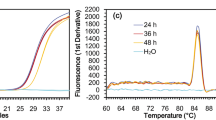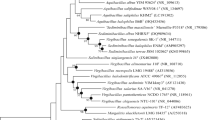Abstract
A lactobionic acid (LBA)-producing bacterium isolated from seaside soils was identified as Acinetobacter halotolerans and designated as strain KRICT-1. We determined whether KRICT-1 can produce LBA at high salt concentrations. The KRICT-1 strain grew on a nutrient broth (NB) agar plate with up to 7.0% NaCl, indicating high NaCl tolerance, and 30 °C was the optimum growth temperature for LBA production. We produced LBA using the KRICT-1 strain in NB medium containing various concentrations of NaCl. While Pseudomonas taetrolens, an efficient LBA-producing bacterium, could produce LBA with up to 5.5% NaCl, the KRICT-1 strain could produce LBA at up to 7.0% NaCl and produced more LBA than P. taetrolens with over 5.5% NaCl. We produced LBA using NB medium containing 7.0% NaCl by batch fermentation of the KRICT-1 strain in a 5 L fermenter. The LBA production titer and productivity of the KRICT-1 strain were 32.1 g/L and 0.22 g/L/h, respectively, which were approximately 1.35- and 1.38-fold higher than those (23.7 g/L and 0.16 g/L/h) obtained from flask culture. Additionally, quinoprotein glucose dehydrogenase is an LBA-producing enzyme in A. halotolerans. We demonstrated that the A. halotolerans KRICT-1 strain is appropriate for LBA production at high salt concentrations.







Similar content being viewed by others
References
Sarenkova I, Ciprovica I (2018) The current status and future perspectives of lactobionic acid production: a review. 233–239
Cardoso T et al (2019) Lactobionic acid as a potential food ingredient: recent studies and applications. J Food Sci 84(7):1672–1681
Pedruzzi I, Borges da Silva EA, Rodrigues AE (2011) Production of lactobionic acid and sorbitol from lactose/fructose substrate using GFOR/GL enzymes from Zymomonas mobilis cells: A kinetic study. Enzyme Microb Technol 49(2):183–191
Sumimoto R et al (1992) An examination of the effects of solutions containing histidine and lactobionate for heart, pancreas, and liver preservation in the rat. Transplantation 53(6):1206–1210
Neaverson MA (1976) Intravenous administration of erythromycin: serum, sputum and urine levels. Curr Med Res Opin 4(5):359–364
Brommage R et al (1993) Intestinal calcium absorption in rats is stimulated by dietary lactulose and other resistant sugars. J Nutr 123(12):2186–2194
Algiert-Zielińska B, Mucha P, Rotsztejn H (2018) Comparative evaluation of skin moisture after topical application of 10% and 30% lactobionic acid. J Cosmet Dermatol 17(6):1096–1100
Tasic-Kostov M et al (2010) Lactobionic acid in a natural alkylpolyglucoside-based vehicle: assessing safety and efficacy aspects in comparison to glycolic acid. J Cosmet Dermatol 9(1):3–10
Alonso S, Rendueles M, Díaz M (2013) Bio-production of lactobionic acid: Current status, applications and future prospects. Biotechnol Adv 31(8):1275–1291
Oh Y-R, Eom GT (2021) Identification of a lactose-oxidizing enzyme in Escherichia coli and improvement of lactobionic acid production by recombinant expression of a quinoprotein glucose dehydrogenase from Pseudomonas taetrolens. Enzyme Microb Technol 148:109828
Murzina EV et al (2008) d-Lactose oxidation over gold catalysts. Catal Today 131(1):385–392
Kuusisto J et al (2007) From renewable raw materials to high value-added fine chemicals—Catalytic hydrogenation and oxidation of d-lactose. Catal Today 121(1):92–99
De Giorgi S et al (2018) Potential use of ricotta cheese whey for the production of lactobionic acid by Pseudomonas taetrolens strains. N Biotechnol 42:71–76
Alonso S, Rendueles M, Díaz M (2012) Role of dissolved oxygen availability on lactobionic acid production from whey by Pseudomonas taetrolens. Biores Technol 109:140–147
Oh YR et al (2020) Enhancement of lactobionic acid productivity by homologous expression of quinoprotein glucose dehydrogenase in Pseudomonas taetrolens. J Agric Food Chem 68(44):12336–12344
Blaschek KM, Wendorff WL, Rankin SA (2007) Survey of salty and sweet whey composition from various cheese plants in Wisconsin. J Dairy Sci 90(4):2029–2034
Kapoor R, Metzger LE (2004) Evaluation of salt whey as an ingredient in processed cheese. J Dairy Sci 87(5):1143–1150
Oh YR, Eom GT (2022) Efficient isolation of new lactobionic acid-producing microorganisms from environmental samples by colloidal calcium carbonate agar plate-based screening. Bioproc Biosyst Eng 45:599–604
Dahal RH, Chaudhary DK, Kim J (2017) Acinetobacter halotolerans sp. nov., a novel halotolerant, alkalitolerant, and hydrocarbon degrading bacterium, isolated from soil. Arch Microbiol 199(5):701–710
Kim J-H et al (2020) High-level production and high-yield recovery of lactobionic acid by the control of pH and temperature in fermentation of Pseudomonas taetrolens. Bioproc Biosyst Eng 43(5):937–944
Olsthoorn AJ, Duine JA (1998) On the mechanism and specificity of soluble, quinoprotein glucose dehydrogenase in the oxidation of aldose sugars. Biochemistry 37(39):13854–13861
Kiryu T et al (2019) Identifying membrane-bound quinoprotein glucose dehydrogenase from acetic acid bacteria that produce lactobionic and cellobionic acids. Biosci Biotechnol Biochem 83(6):1171–1179
Matsushita K et al (1997) Escherichia coli is unable to produce pyrroloquinoline quinone (PQQ). Microbiology 143(10):3149–3156
Oh Y-R et al (2020) Efficient production of lactobionic acid using genetically engineered Pseudomonas taetrolens as a whole-cell biocatalyst. Enzyme Microb Technol 141:109668
Alarico S et al (2005) Distribution of genes for synthesis of trehalose and Mannosylglycerate in Thermus spp and direct correlation of these genes with halotolerance. Appl Environ Microbiol 71(5):2460–2466
Makihara F et al (2005) Role of trehalose synthesis pathways in salt tolerance mechanism of Rhodobacter sphaeroides f. s.p denitrificans IL106. Arch Microbiol 184(1):56–65
Reina-Bueno M et al (2012) Role of trehalose in salinity and temperature tolerance in the model halophilic bacterium Chromohalobacter salexigens. PLoS One 7(3):e33587
Li Z et al (2013) Experimental and modeling approaches for food waste composting: a review. Chemosphere 93(7):1247–1257
Wei Q et al (2014) Performance and kinetic evaluation of a semi-continuously fed anaerobic digester treating food waste: Effect of trace elements on the digester recovery and stability. Chemosphere 117:477–485
Gou C et al (2014) Effects of temperature and organic loading rate on the performance and microbial community of anaerobic co-digestion of waste activated sludge and food waste. Chemosphere 105:146–151
He X et al (2019) Characteristics of acidogenic fermentation for volatile fatty acid production from food waste at high concentrations of NaCl. Biores Technol 271:244–250
Jeison D, Del Rio A, Van Lier JB (2008) Impact of high saline wastewaters on anaerobic granular sludge functionalities. Water Sci Technol 57(6):815–819
Kim D-H, Kim S-H, Shin H-S (2009) Sodium inhibition of fermentative hydrogen production. Int J Hydrogen Energy 34(8):3295–3304
Funding
This work was supported in part by the R&D programs of KRICT (SS2242-10, BSF22-505) and Ulsan-KRICT (US22-03).
Author information
Authors and Affiliations
Contributions
HJH: Investigation, validation, data curation, writing of the original draft. GTE: Conceptualization, project administration, supervision, writing–original draft, writing–review and editing, funding acquisition, resources.
Corresponding author
Ethics declarations
Conflict of interest
The authors declare no financial or commercial conflict of interest.
Additional information
Publisher's Note
Springer Nature remains neutral with regard to jurisdictional claims in published maps and institutional affiliations.
Supplementary Information
Below is the link to the electronic supplementary material.
Rights and permissions
Springer Nature or its licensor holds exclusive rights to this article under a publishing agreement with the author(s) or other rightsholder(s); author self-archiving of the accepted manuscript version of this article is solely governed by the terms of such publishing agreement and applicable law.
About this article
Cite this article
Han, H.J., Eom, G.T. Production of lactobionic acid at high salt concentrations by Acinetobacter halotolerans isolated from seaside soil. Bioprocess Biosyst Eng 45, 1683–1691 (2022). https://doi.org/10.1007/s00449-022-02773-1
Received:
Accepted:
Published:
Issue Date:
DOI: https://doi.org/10.1007/s00449-022-02773-1




